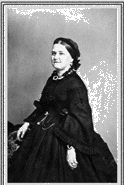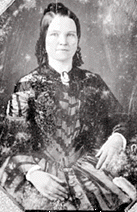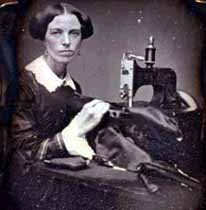October 01, 2001
Civil War Women
![]()
 Mary Todd was born to an affluent Kentucky family and received a genteel education at private academies near Lexington. She met Abraham Lincoln in 1839 in Springfield, Illinois, at the home of her sister and brother-in-law. Though Lincoln's lack of social position aroused their objections, she became engaged to the ambitious lawyer, and they married in 1842. Mary Todd Lincoln lived happily in Springfield, as her husband rose in the ranks of the Whig Party. She enthusiastically supported her husband's presidential ambitions, yet, as first lady she found herself constantly under attack.
Mary Todd was born to an affluent Kentucky family and received a genteel education at private academies near Lexington. She met Abraham Lincoln in 1839 in Springfield, Illinois, at the home of her sister and brother-in-law. Though Lincoln's lack of social position aroused their objections, she became engaged to the ambitious lawyer, and they married in 1842. Mary Todd Lincoln lived happily in Springfield, as her husband rose in the ranks of the Whig Party. She enthusiastically supported her husband's presidential ambitions, yet, as first lady she found herself constantly under attack.
She disappointed southerners, who felt betrayed by her opposition to slavery; northerners distrusted her; and many of Lincoln's colleagues disliked her. Unfriendly memoirs describe her temper, her extravagance, and her sarcasm, but Lincoln's own letters show a consistent, affectionate regard for his wife and family. Many historic accounts allude to the fact that she may have suffered from severe PMS - an unknown medical term in the 19th century. This portrait was made in Brady's studio in 1863, when Mrs. Lincoln was still in mourning for her son Willie, who had died in the White House in February 1862.
|
| Photograph from the LCCW collection |

This daguerreotype of Mary Todd Lincoln, taken in 1846 or 1847, captures her youthful beauty. The photographer was possibly Nicholas H. Shepherd.

While Grant was assigned to the 4th Infantry Regiment, then stationed near St. Louis, he met Julia Dent, the sister of a classmate. They fell in love and soon became engaged, against the wishes of her father. The couple waited over two more years before they could marry, due to Grant's service in Texas and Mexico. The separations that began with their engagement continued throughout Julia and Ulysses Grant's married life, prompting them to maintain a frank, affectionate correspondence. Today, Grant's letters to Julia reveal a keen and thoughtful reaction to modern warfare, and an unusually strong bond between husband and wife. In 1864, Brady added Julia Grant's portrait to his series devoted to Union generals and their wives. |
Photograph from the Library of Congress Civil War Collection

This Carriage Shoe is made of black or any dark-colored velvet, richly embroidered, and bound with satin ribbon. The sole is of stout wash leather, wadded and lined with satin. It is a warm and handsome carriage shoe.

The unidentified subject of this daguerreotype (ca.1853) sits behind an industrial model Grover and Baker sewing machine. Whether originally produced as a promotion for the machine's manufacturer, an illustration of the clothing industry at the time, or a portrait of a proud seamstress displaying the tools of her trade, this daguerreotype is one of the few surviving visual documents of working women in the United States before the Civil War. Photographer unidentified: Library of Congress Civil War Collection. |
During long voyages at sea, vessels began to operate on-board company stores stocked with clothing from the ship’s "slop chest", as well as tobacco, and other necessities for the crew.
Eventually, with the aid of new technology, a shift in popular taste to looser-fitting men’s fashions and the increasing social acceptance of ready-made clothing, the clothing industry seized the opportunity to produce and sell a wide variety of ready-to-wear men’s garments. Furthermore, by 1860, two thirds of the ready-to-wear garments made in New York were sold to the south.
Necessity of the Civil War forced the ready-to-wear garment manufacturers to meet the constant demand for uniforms. To accomplish this enormous task, manufacturers began building factories and developing networks of seamstresses. More efficient production methods and a better understanding of sizing helped them to meet the consumer demands. However, the ladies who were required to rapidly turn out these garments worked in conditions that were compared by some to the slave trade.
Naturally, this did not as quickly apply to the fairer sex, whose styles still required close-fitting custom tailored clothing. Aside from commercially produced commodities such as cloaks, corsets, and hoops, most women's clothing in the mid-19th century was still custom-made at home or, for those whose allowance was more flexible, by dressmakers.